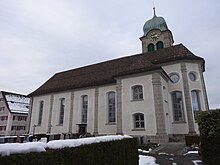St. Jakobus (Feusisberg)
The St. Jakobus Church is a baroque parish church in the municipality of Feusisberg ( Switzerland ). She is known for her unusual pictorial program directed against the Reformation and the Enlightenment . The church is situated on a terrace in a dominant position high above Lake Zurich .
history
A chapel already existed in Feusisberg, on the pilgrimage route from Rapperswil to Einsiedeln , in the Middle Ages . In 1509 the church was elevated to a parish church in the course of a new building. To this day the parish is in the hands of monks from the Benedictine Abbey of Einsiedeln . 1679 the church was through the translation of the relics of St. St. Theodore the Sanctuary .
During the term of office of Abbot Beat Küttel from Einsiedeln , a new building was planned from 1779, at the same time as the neighboring village of Wollerau . The Jakobuskirche in Feusisberg and the Verenenkirche in Wollerau have a similar spatial concept and an extraordinary iconographic program that emphasizes the central teachings of the Catholic Church in contrast to the Reformed teaching and the Enlightenment . This circumstance is to be seen in connection with the influence of the conservative abbot Beat Küttel and the location of both churches not far from the border to the reformed canton of Zurich . The construction work was carried out 1780–1785 under the direction of Johannes Haltmayer , possibly according to plans by Nikolaus Purtschert .
description
Exterior
The church is a spacious hall church with a polygonal choir in the east. A tower with an onion dome, visible from afar, is attached to the choir . The plastered facades are structured by pilasters made of exposed masonry.
inner space
The bright, festive interior is illuminated by segmented arched windows in the nave and an additional row of oculi in the choir. The interior of the church is structured by double pilasters of Ionic order , from which stab caps extend towards the center of the vault . The baroque high altar dates from the construction period, while the side altars and pulpit were taken over from the Verena minster in Zurzach in 1938 as a replacement for neo-Romanesque furnishings from the 19th century . The organ is on the rear gallery .
Image program
The ceiling frescoes from the construction period were made by the Mesmer family of artists . Instead of stucco cartridges , painted cartridges were used as frames. The ceiling paintings in the ship show scenes from the Christmas story.
The ceiling fresco in the choir, on the other hand, is likely to be unique: it depicts the triumph of Ecclesia over heresy in an allegorical manner . The figure of Ecclesia as an allegory of the Roman Catholic Church hovers on a cloud under the dove of the Holy Spirit . She carries a cross and a chalice with a host in her hands as symbols of Catholic teaching. Furthermore, numerous putti surrounding them bear other symbols of the Roman Church: a tiara , a ferula and the key of Peter . Other putti hurl lightning bolts at the people shown in the lower half of the picture, who, in contrast to the allegorical figures of the Catholic Church, are historical figures. Centrally represented are the Enlightenment philosophers Voltaire and Jean-Jacques Rousseau , as well as the reformers Huldrych Zwingli , Martin Luther and Jean Calvin, depicted in a clownish manner, and the early medieval theologians Arius and Photius , who were rejected by the Roman Church .
To make the triumph of the Catholic Church over heresy the subject of a ceiling painting is in itself extraordinary. The fact that seven prominent critics of Catholic dogmatics are immortalized on a church ceiling as a representative of the heresy, and in a situation of implied condemnation, is unique in this form.
literature
- Jutta Betz: Feusisberg. Parish Church St. Jakobus , Passau 2009.
- Michael D. Schmid: Demarcation in the border area. Confessional self-presentation. , in: etü. Historians' journal. 1/2014, pp. 36-39.
Web links
Coordinates: 47 ° 11 '15.4 " N , 8 ° 44' 51.8" E ; CH1903: six hundred ninety-nine thousand two hundred and thirteen / 227123



